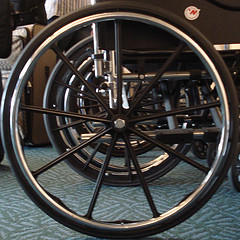
Photo credit: Tom Magliery on Flickr
I asked a friend about his plan for evacuating the building he works in. He said he didn’t really have one – even though it could be difficult for him to get out if the elevator fails, since he uses a wheelchair.
He’s one of the first people I thought about when I read about new WorkSafeBC requirements for emergency planning and response. How would he get out if the elevator broke down and everyone relied on the stairs?
He said his workplace didn’t have a plan in place, and he had never discussed it with his employers or coworkers. At home he is on the ground floor and would wheel straight outside, but at work he uses an elevator.
He laughed – a bit nervously – and said he hadn’t thought about it before. I’m sure he’s not alone, which is why I’m glad to see this new regulation will get some important conversations going.
Employers are advised to get started by taking a walk through the facility to identify any workers’ barriers to evacuation, according to the BC Coalition of People with Disabilities.
What affects people’s ability to evacuate during an emergency?
Hearing impairments may affect people’s ability to hear emergency warning systems or aural instructions. Visual impairments can limit ability to identify escape routes, directional information, instructions, objects, or hazards.
Respiratory disabilities may limit people’s ability to walk long distances – which may be exacerbated by smoke, dust, fumes, and chemicals. Other barriers can result when people have challenges with speech, cognitive challenges, or mental illness/disorders.
Where in the Reg?
The requirements for emergency preparedness and response are described in sections 4.13 through 4.18 of the Occupational Health and Safety Regulation.
“There are often workers with disabilities in every workplace, and some disabilities may not be obvious, or even known to employers or coworkers,” reads this WorkSafeBC announcement.
“General workplace emergency plans do not often address the needs of people with disabilities, and put workers at risk.”
I’m glad to see this new regulation and wonder if any of you have your own experiences preparing for people’s individual needs to get out of the building.



Congratulations for this entry in your blog! Many companies in Spain don’t take any measure to prepare workers in case of a real emergency. Often safety measures are general and not addresed to any individual, without any particular approach according to the physical or psychological conditions. In my opinion all of us can develop a “disability/ handicap / special conditions” even during short time (several days or weeks). It’s better designing safety measure addressed to every individual that generalising to the group. A successful and quick evacuation is related to a rational design and a training in behaviour and responses before emergencies.
Best regards!